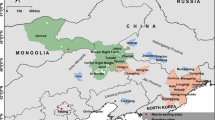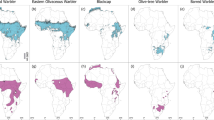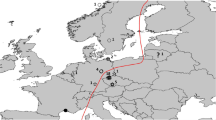Abstract
Management of migratory game birds must be considered at the flyway scale. Flyway delineation has generally relied on ring recoveries, yet migratory connectivity between breeding and wintering grounds is often difficult to demonstrate due to low ring-recovery rates. To overcome the limitations of ring recoveries, we here relied on stable-hydrogen isotope ratios (δ 2H) from feathers of 939 hunted Teal (Anas crecca) in France in the winters of 2002–2003 to 2005–2006 to determine the geographic origin of these individuals. Likelihood-based assignment analyses, including the use of Bayesian priors based on ring recoveries, suggest that Teal wintering in France mostly originate from Russia, up to the Ural Mountains, and to a lesser extent from Finland. This suggests that more collaboration with Russia for the management of Teal in Europe should be encouraged. Our study identifies Teal breeding hotspots, which should receive greater research and monitoring attention. Our isotope assignment results can be used as a reference value in time against which future similar analyses could be compared, potentially to track geographic shifts linked with habitat and climate change.
Zusammenfassung
Eingrenzung der geographischen Herkunft der Krickente ( Ansas crecca ) durch stabile Wasserstoffisotope ( δ 2H) aus Federn und durch Ringwiederfunde
Das Management von ziehendem Federwild muss den gesamten Zugweg mit einkalkulieren. Der Verlauf des Zugweges wurde bisher meist anhand von Ringwiederfunden abgeschätzt, doch aufgrund geringer Wiederfundraten konnte die Verbundenheit von Brut- und Wintergebieten oft nur schwer nachgewiesen werden. Um die Schwächen der Ringwiederfunddaten zu umgehen, nutzten wir stabile Isotope des Wasserstoffs (δ2H) aus Federn von 939 in Frankreich gejagten Krickenten (Anas crecca) aus den Wintern von 2002–2003 bis 2005–2006 zur Bestimmung der Herkunft dieser Vögel. Anhand von Likelihood-Analyse unter der Anwendung von Bayesscher A-Priori-Verteilung basierend auf Ringfunden, konnten wir die in Frankreich überwinternden Krickenten ihren Brutgebieten zuordnen. Diese schienen hauptsächlich in Russland bis hin zum Uralgebirge und zu einem geringeren Anteil in Finnland zu liegen. Dies legt nahe, dass eine engere Zusammenarbeit mit Russland in Bezug auf Krickentenbestände in Europa wünschenswert wäre. Unsere Studie zeigt die Hauptbrutgebiete, welche in Zukunft näher erforscht und besser überwacht werden sollten. Unsere Isotopenanalyse kann als Referenzpunkt für weitere ähnliche Analysen in der Zukunft genommen werden, um mögliche geographische Verschiebungen in Zusammenhang mit Habitatveränderung und Klimawandel verfolgen zu können





Similar content being viewed by others
References
Baker K (1993) Identification guide to European non-passerines. The British Trust for Ornithology (BTO Guide 24), Thetford
Beyer HL (2004) Hawth’s analysis tools for ArcGIS. http://www.spatialecology.com/htools
Bowen GJ, Wassenaar LI, Hobson KA (2005) Global application of stable hydrogen and oxygen isotopes to wildlife forensics. Oecologia 143:337–348
Brown LH, Urban EK, Newman K (1982) The birds of Africa, vol 1. Academic Press, London
Burnham KP, Anderson DR (2002) Model selection and multi-model inference: a practical information-theoretic approach, 2nd edn. Springer, Berlin
Chabot AA, Hobson KA, Van Wilgenburg SL, McQuat G, Lougheed SC (2012) Advances in linking wintering migrant birds to their breeding-ground origins using combined analyses of genetic and stable isotope markers. PLoS ONE 7(8):e43627
Clark RG, Hobson KA, Wassenaar LI (2006) Geographic variation in the isotopic (δD, δ 13C, δ 15N, δ 34S) composition of feathers and claws from lesser scaup and northern pintail: implications for studies of migratory connectivity. Can J Zool 84:1395–1401
Clark RG, Hobson KA, Wassenaar LI (2009) Corrigendum—geographic variation in the isotopic (δD, δ 13C, δ 15N, δ 34S) composition of feathers and claws from lesser scaup and northern pintail: implications for studies of migratory connectivity. Can J Zool 87:553–554
Dement’ev GP, Gladkov NA (eds) (1952) Ptitsy Sovetskogo Soyuza (Birds of the Soviet Union—Volume VI). Soviet Science State Publisher, Moscow (English version provided by the Israel Program for Scientific Translations, Jerusalem, 1967)
Elmberg J, Nummi P, Pöysä H, Sjöberg K, Gunnarsson G, Clausen P, Guillemain M, Rodrigues D, Väänänen V-M (2006) The scientific basis for a new and sustainable management of migratory European ducks. Wildl Biol 12:121–128
Guillemain M, Sadoul N, Simon G (2005) European flyway permeability and abmigration in Teal (Anas crecca), an analysis based on ringing recoveries. Ibis 147:688–696
Guillemain M, Poisbleau M, Denonfoux L, Lepley M, Moreau C, Massez G, Leray G, Caizergues A, Arzel C, Rodrigues D, Fritz H (2007) Multiple tests of the effect of nasal saddles on dabbling ducks: combining field and aviary approaches. Bird Study 54:35–45
Guillemain M, Hearn R, King R, Gauthier-Clerc M, Simon G, Caizergues A (2009a) Comparing migration of Teal from two main wintering areas of Western Europe: a long term study from Essex, England, and Camargue, France. Ring Migr 24:273–276
Guillemain M, Hearn R, King R, Gauthier-Clerc M, Simon G, Caizergues A (2009b) Differential migration of the sexes cannot be explained by the body size hypothesis in Teal. J Ornithol 150:685–689
Guillemain M, Bertout JM, Christensen TK, Pöysä H, Väänänen VM, Triplet P, Schricke V, Fox AD (2010) How many juvenile Teal Anas crecca reach the wintering grounds ? Flyway-scale survival rate inferred from age-ratio during wing examination. J Ornithol 151:51–60
Guillemain M, Pöysä P, Fox AD, Arzel C, Dessborn L, Ekroos J, Gunnarsson G, Holm TE, Christensen TK, Lehikoinen A, Mitchell C, Rintala J, Møller AP (2013) Effects of climate change on European ducks: what do we know and what do we need to know? Wild Biol (in press)
Gunnarsson G, Latorre-Margalef N, Van Wilgenburg SL, Hobson KA, Waldenström J, Elmberg J, Olsen B (2012) Disease dynamics and bird migration—linking Mallards Anas platyrhynchos and influenza A virus in time and space. PLoS ONE 7(4):e35679
Hobson KA (2008) Applying isotopic methods to tracking animal migration. In: Hobson KA, Wassenaar LI (eds) Tracking animal migration with stable isotopes. Academic Press, London, pp 45–78
Hobson KA, Bowen GJ, Wassenaar LI, Ferrand Y, Lormée H (2004) Using stable hydrogen and oxygen isotope measurements of feathers to infer geographic origins of migrating European birds. Oecologia 141:477–488
Hobson KA, Wunder MB, Van Wilgenburg SL, Clark RG, Wassenaar LI (2009) A method for investigating population declines of migratory birds using stable isotopes: origins of harvested lesser scaup in North America. PLoS ONE 4(11):e7915
Huntley B, Green R, Collingham Y, Willis SG (2007) A climatic atlas of European breeding birds. Lynx Edicions, Barcelona
Intergovernmental Panel on Climate Change (1997) The regional impacts of climate change: an assessment of vulnerability. In: Watson RT, Zinyowera MC, Moss RH (eds). Cambridge University Press, Cambridge
Korner-Nievergelt F, Liechti F, Hahn S (2012) Migratory connectivity derived from sparse ring reencounter data with unknown numbers of ringed birds. J Ornithol 153:771–782
Legagneux P, Clark RG, Guillemain M, Eraud C, Théry M, Bretagnolle V (2012) Large-scale geographic variation in iridescent structural ornaments of a long-distance migratory bird. J Avian Biol 43:355–361
Lund U, Agostinelli C (2011) Circular: Circular statistics. R package version 0.4-2. http://CRAN.R-project.org/package=circular
Mazerolle MJ (2012) AICcmodavg: model selection and multimodel inference based on (Q)AIC(c). R package version 1.26. http://CRAN.R-project.org/package=AICcmodavg
North American Waterfowl Management Plan (2012) People conserving waterfowl and wetlands. http://nawmprevision.org/
Nummi P, Paasivaara A, Suhonen S, Pöysä H (2013) Wetland use by brood-rearing female ducks in a boreal forest landscape: the importance of food and habitat. Ibis 155:68–79
Perdeck AC (1977) The analysis of ringing data: pitfalls and prospects. Vogelwarte 29:S33–S44
R Core Team (2012) R: a language and environment for statistical computing. R Foundation for Statistical Computing, Vienna, Austria. http://www.r-project.org/
Robinson RA, Grantham MJ, Clark JA (2009) Declining rates of ring recovery in British birds. Ring Migr 24:266–272
Rousselot JC, Trolliet B (1991) Critères de détermination du sexe et de l’âge des canards. Office National de la Chasse et de la Faune Sauvage, Paris
Royle JA, Rubenstein DR (2004) The role of species abundance in determining breeding origins of migratory birds with stable isotopes. Ecol Appl 14:1780–1788
Salomonsen F (1968) The moult migration. Wildfowl 19:5–24
Scott DA, Rose PM (1996) Atlas of Anatidae populations in Africa and Western Eurasia. Wetlands International Publication 41. Wetlands International, Wageningen
UNEP/AEWA Secretariat (2012) Agreement on the conservation of African-Eurasian Migratory Waterbirds (AEWA). Agreement text and action plan (version adopted by MOP5). UNEP/AEWA, Bonn. http://www.unep-aewa.org
Van Wilgenburg SL, Hobson KA (2011) Combining stable-isotope (δD) and band recovery data to improve probabilistic assignment of migratory birds to origin. Ecol Appl 21:1340–1351
Wassenaar LI, Hobson KA (2003) Comparative equilibration and online technique for determination of non-exchangeable hydrogen of keratins for use in animal migration studies. Isotopes Environ Health Stud 39:211–217
Wunder MB (2010) Using isoscapes to model probability surfaces for determining geographic origins. In: West JB, Bowen GJ, Dawson TE, Tu KP (eds) Isoscapes: understanding movement, pattern, and process on Earth through isotope mapping. Springer, New York, pp 251–270
Acknowledgments
We thank the many Teal ringers who took part in this programme, and the many hunters who voluntarily provided Teal wings for this study. We also acknowledge the valuable help of Patrice Noble and Franck Latraube in processing the wings in the laboratory for measurement of length and sex/age determination. L.I. Wassenaar assisted with isotope measurements, and an anonymous reviewer and Gunnar Gunnarsson provided valuable comments on an earlier version of the manuscript.
Author information
Authors and Affiliations
Corresponding author
Additional information
Communicated by F. Bairlein.
Rights and permissions
About this article
Cite this article
Guillemain, M., Van Wilgenburg, S.L., Legagneux, P. et al. Assessing geographic origins of Teal (Anas crecca) through stable-hydrogen (δ 2H) isotope analyses of feathers and ring-recoveries. J Ornithol 155, 165–172 (2014). https://doi.org/10.1007/s10336-013-0998-4
Received:
Revised:
Accepted:
Published:
Issue Date:
DOI: https://doi.org/10.1007/s10336-013-0998-4




